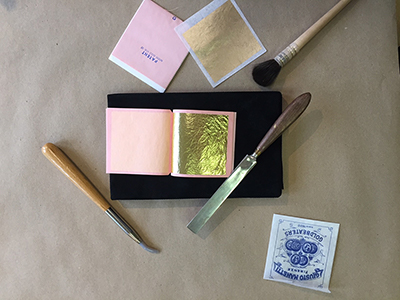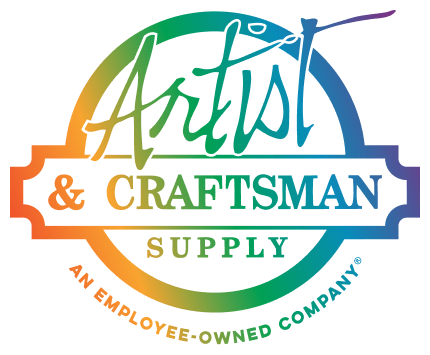Posted by Curry S. on Jan 21st 2020
A Guide to Gilding with Sepp Leaf
All that glitters is gold if you gild it. We partnered up with Sepp Leaf to bring you a brief history of gilding! Stay tuned for a couple golden DIYs!
A Brief Primer on Gilding – History and Overview
The art of gilding – applying a thin layer of gold leaf to produce a finish that simulates the appearance and luster of solid gold – has evolved over thousands of years. Modern methods and materials have expanded the creative possibilities for many kinds of precious and non-precious metal leaf – gold, silver, platinum, copper, brass and more – to enhance a growing array of surfaces.

Ancient Egyptian goldbeating.

Tools of the gilding trade
Application and Manufacture
As early as 2600 B.C.E., Egyptians relied on a plentiful supply of gold to embellish tomb paintings and mummies, believing that gold gave their dead permanence and beauty in the afterlife, and even the ability to speak to the gods in their own language. Other reliquary objects like masks, vessels and papyrus were also gilded, often using a resinous glue to attach the gold leaf. Possibly importing the technology of goldbeating from China, Japanese artisans from the 8th century B.C.E. mined gold in the Kanazawa district and developed a highly sophisticated system using special papers made from plant pulp used with ingredients such as rice ash, cold river water, egg, and persimmon. These papers or “molds” helped beat the gold super thin. Gold leaf remains popularly used over traditional Japanese lacquer, which is impervious to water and enhances the brilliance of the gold. Gold leaf was also applied over an animal glue base for wooden objects such as murals. Again, gold was prized for its permanence, and used to symbolize the eternal nature of the Buddha. Gold leaf’s use expanded greatly in Europe and globally, during the Middle Ages and the Renaissance, with the growth of religious architecture and imagery.

(Left) USS Maine monument gilded 1995 by Bill Gauthier and New York’s Central Park Conservancy. Photo credit: Bill Gauthier
(Right) “America” Eagle Carving by J.P. Uranker Woodcarver
To create gold leaf, pure or alloyed metals are melted to approximately 1300°C/2372°F and slowly cooled in water. The metal is then alternately rolled and reheated, or annealed, a few times to avoid brittleness. Rolled strips of metal about 1/1000” thick are put into molds or interleaves, typically made of treated vellum. Today’s molds are generally made with synthetic materials. Hand beating has been replaced by computer-controlled carousel hammers that beat rotating molds, usually in two stages.
Gilding Systems
There are a few basic gilding methods, each appropriate for specific surfaces and environments, including water gilding, oil gilding, and synthetic gilding. Let’s have a look at these:
Traditional Water Gilding - this method allows you to create matte and burnished/reflective gold surfaces for interior applications, and is used with genuine gold, silver and palladium leaf. It involves many layers of gesso and bole using animal-based glue, as well as plenty of surface preparation to ready the surface for a clean gild.
Oil Gilding - a simpler method used with genuine leaf indoors or outdoors, (depending on the karat) and with metal leaf (indoors only). It usually involves sealing and coloring the surface to be gilded, then the application of size (adhesive). Generally, there are two types of size - “quick” and “slow”. Quick size is usually ready to gild within a few hours and allows a brief time during which gilding can be accomplished. Slow size is often ready to gild within 12-24 hours and usually allows 12-24 hours to do the gilding.
Synthetic Gilding – uses a family of man-made, water-based adhesives or “sizes” that provide a wide range of controlled drying times and finishes, from matte to very reflective. These adhesives are designed for used with metal leaf and/or gold leaf and can replicate a traditional oil-based or brilliant water-based gilding appearance.

Neoclassical frame ca. 1808, before, during and after conservation treatment. Photo courtesy of Gold Leaf Studio
Gold Leaf Types & Terminology
Pure 24 kt. gold leaf and pure platinum leaf (silver colored) are impervious to acids and will not oxidize. Pure gold leaf is the softest and most malleable type of leaf. Palladium leaf (also silver colored) is susceptible to nitric acid. Gold leaf in 23kt, 23.50kt and 23.75kt are alloyed with silver, palladium, and/or copper, and are suitable for exterior gilding. Gold leaf in 22kt is suitable for interior gilding only and does not tarnish if left unsealed. Karats below 22kt, as well as genuine silver, imitation gold (aka Dutch metal, brass, or bronze leaf) pure copper leaf and aluminum leaf will oxidize in interior settings if left unsealed and should not be used outdoors.
Loose Leaf - is assembled by placing each leaf between pages of thin paper and must be handled using a special brush called a gilder’s tip.
Regular or Surface Leaf - refers to the average thickness of the gold leaf which varies by manufacturer. The weight is measured in grams per 1000 stacked leaves.
Double Gold Leaf - may be 10-20% thicker than loose leaf.
Glass Gold Leaf - is selected for its higher quality (visible when used on glass) and should have minimal pinholes or irregularities.
Patent Leaf - is leaf that has been pressed to a tissue paper backing, then interleaved within pages of paper. This allows the gilder to handle the gold without a gilder’s tip, and is useful for gilding in the wind, and/or on flat surfaces.
Ribbon Leaf - is made of overlapped squares of leaf on a length of lightly waxed paper.

(Left) “Acrobat”, metal leaf and oils by Susan Makara
(Right) “Iitate” reverse gilded glass with moon gold leaf and palladium leaf by Matt Meyer
Over the centuries, gold leaf has been used around the world to ornament surfaces and objects of both religious and secular significance, including houses of worship, seats of government, objets d’art, illuminated images, texts and statuary, musical instruments, furniture and furnishings, wallcoverings, glass and ceramics, architectural elements, and even food. While the methods remained similar with variations on the use of both oil-based and water-based, organic grounds and adhesives, gold leaf began to be used more widely in both the east and the west, though still reserved mostly for the wealthy. Fortunately for us, gilding with gold and other metal leaf is now much more affordable and accessible. Modern materials and methods allow us to embellish nearly any creative project with the lasting beauty of gold.

“St. George” Gilded Icon by Annunciation Press.
Sources:
Gilded Wood, 1991 Soundview Press, Editor Deborah Bigelow
Historic Preservation, R.S. Means, 2000.
Copyright 2017 Jennifer Longworth

